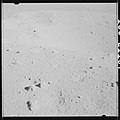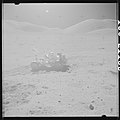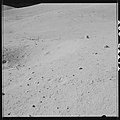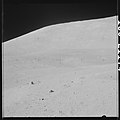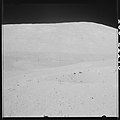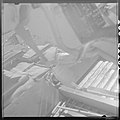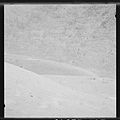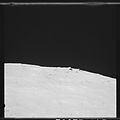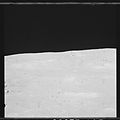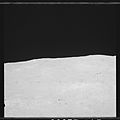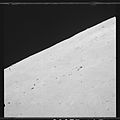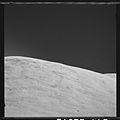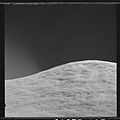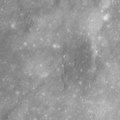Category:Apollo 17 EVA at Station 3
From the Apollo 17 Preliminary Science Report, Chapter 5 (NASA SP-330, 1973):
Excerpt from The Light Mantle Area
The plume- or ray-shaped light-albedo area that extends northward from the South Massif is known as the light mantle. Photogeologic interpretation suggested that this was a relatively young mantling material derived from the South Massif talus. The geometry of its contact and the dark material excavated by some of the larger craters on it strongly suggest that the light mantle deposition occurred after most of the dark floor material had been deposited. Whether this light mantle material was a ray of ejecta or mobilized South Massif talus or both and speculation on the possible mechanisms of deposition were questions posed in our premission planning.
The surface of the light mantle is composed of loose, medium-gray, finely seriate debris with an apparently large deficiency of fragments in size ranges greater than approximately 1 cm. Very few rock fragments or boulders larger than a few centimeters were observed; this characteristic contrasts sharply with the talus debris on the South Massif. The light mantle surface was very similar in general visual character, however, to the fine debris surface on the South Massif talus slope. Fragments of breccia similar to those at station 2 were found slightly concentrated on the rim of and inside the 30-m-diameter Ballet Crater in the light mantle at station 3. In general, fragment concentrations were present on the rims and in the walls of craters having diameters greater than approximately 5 m.
A dilated and inverted section of the light mantle may be present in the fine-grained debris just outside the rim of Ballet Crater. A trench in this rim (AS17-138-21148) showed the debris to be layered from the surface downward as follows: 1. Approximately 0.5 cm of medium-gray surface material (possibly new regolith) similar to the surface layer on the light mantle 2. Approximately 3 cm of light-gray material similar to the subsurface material of the light mantle 3. At least 15 cm of medium- to dark-gray material into which light-gray material is marbled
The talus slopes of the massifs clearly have a higher rock fragment abundance than does the average surface of the dark floor material; however, the surface of the light mantle has a distinctly lower fragment abundance in the 2- to 10-cm size range. The same relations hold for fragments larger than 10 cm. Observations of crater characteristics infer that concentrations of rock fragments occur at depths of approximately 1 m below the surface of the light mantle.
Light-gray material is present 5 to 10 cm below the medium-gray surface material at all localities investigated in the light mantle area. Light-gray material is also present in the walls of all craters in this area having diameters greater than approximately 1 m. This soil profile is very similar to that developed on the massif talus slopes.
The contacts between the light mantle and both the dark floor material of the valley and the dark material around Shorty Crater (Station 4) are gradational in albedo over a distance of approximately 10 m. A distinct difference in albedo of the two types of surfaces is visible when viewed at zero-phase angle. Also, there is an obvious change in the wall color of craters larger than 1 m in diameter. No topographic expression at these contacts was detected.
Media in category "Apollo 17 EVA at Station 3"
The following 79 files are in this category, out of 79 total.
-
A17 PSR Figure 6-108 Station 3.gif 300 × 283; 8 KB
-
AS17-137-20981 (21496541948).jpg 4,175 × 4,175; 5.6 MB
-
AS17-137-20982 (21497553579).jpg 4,175 × 4,175; 5.65 MB
-
AS17-138-21143 (21497297138).jpg 4,175 × 4,175; 4.84 MB
-
AS17-138-21144 (21064140503).jpg 4,175 × 4,175; 4.87 MB
-
AS17-138-21145 (21673701172).jpg 4,175 × 4,175; 4.95 MB
-
AS17-138-21146 (21497286478).jpg 4,175 × 4,175; 4.52 MB
-
AS17-138-21147 (21685123965).jpg 4,175 × 4,175; 4.82 MB
-
AS17-138-21148 (21497198660).jpg 4,175 × 4,175; 4.7 MB
-
AS17-138-21149 (21673700642).jpg 4,175 × 4,175; 4.7 MB
-
AS17-138-21150 (21497295818).jpg 4,175 × 4,175; 4.29 MB
-
AS17-138-21151 (21497188010).jpg 4,175 × 4,175; 4.53 MB
-
AS17-138-21152 (21498305959).jpg 4,175 × 4,175; 4.29 MB
-
AS17-138-21153 (21673699822).jpg 4,175 × 4,175; 4.39 MB
-
AS17-138-21154 (21685122585).jpg 4,175 × 4,175; 4.45 MB
-
AS17-138-21155 (21498305049).jpg 4,175 × 4,175; 4.49 MB
-
AS17-138-21156 (21685121715).jpg 4,175 × 4,175; 4.58 MB
-
AS17-138-21157 (21497187820).jpg 4,175 × 4,175; 4.77 MB
-
AS17-138-21158 (21062443754).jpg 4,175 × 4,175; 4.56 MB
-
AS17-138-21159 (21497293938).jpg 4,175 × 4,175; 4.64 MB
-
AS17-138-21160 (21497195880).jpg 4,175 × 4,175; 4.84 MB
-
AS17-138-21161 (21659065746).jpg 4,175 × 4,175; 4.54 MB
-
AS17-138-21162 (21497293508).jpg 4,175 × 4,175; 4.52 MB
-
AS17-138-21163 (21694325931).jpg 4,175 × 4,175; 4.5 MB
-
AS17-138-21164 (21497195050).jpg 4,175 × 4,175; 4.5 MB
-
AS17-138-21165 (21685120395).jpg 4,175 × 4,175; 4.49 MB
-
AS17-138-21166 (21673697282).jpg 4,175 × 4,175; 4.63 MB
-
AS17-138-21167 (21064136293).jpg 4,175 × 4,175; 4.53 MB
-
AS17-138-21168 (21497285918).jpg 4,175 × 4,175; 4.58 MB
-
AS17-138-21169 (21498302569).jpg 4,175 × 4,175; 4.74 MB
-
AS17-138-21170 (21064135973).jpg 4,175 × 4,175; 4.43 MB
-
AS17-138-21171 (21498302089).jpg 4,175 × 4,175; 4.68 MB
-
AS17-138-21172 (21685119265).jpg 4,175 × 4,175; 4.44 MB
-
AS17-138-21173 (21064129223).jpg 4,175 × 4,175; 4.43 MB
-
AS17-138-21174 (21497291738).jpg 4,175 × 4,175; 4.54 MB
-
AS17-138-21175 (21498301019).jpg 4,175 × 4,175; 4.69 MB
-
AS17-138-21176 (21497192760).jpg 4,175 × 4,175; 4.35 MB
-
AS17-138-21177 (21062440254).jpg 4,175 × 4,175; 4.31 MB
-
AS17-138-21178 (21659062586).jpg 4,175 × 4,175; 4.8 MB
-
AS17-138-21179 (21064129073).jpg 4,175 × 4,175; 4.39 MB
-
AS17-138-21180 (21694323091).jpg 4,175 × 4,175; 4.56 MB
-
AS17-138-21181 (21062439704).jpg 4,175 × 4,175; 4.22 MB
-
AS17-138-21182 (21064133533).jpg 4,175 × 4,175; 6.74 MB
-
AS17-144-22047 (21491340030).jpg 4,175 × 4,175; 4.98 MB
-
AS17-144-22048 (21491431588).jpg 4,175 × 4,175; 4.85 MB
-
AS17-144-22049 (21058282383).jpg 4,175 × 4,175; 4.94 MB
-
AS17-144-22050 (21679258325).jpg 4,175 × 4,175; 4.89 MB
-
AS17-144-22051 (21653201946).jpg 4,175 × 4,175; 4.59 MB
-
AS17-144-22052 (21492440289).jpg 4,175 × 4,175; 4.61 MB
-
AS17-144-22053 (21491333080).jpg 4,175 × 4,175; 4.71 MB
-
AS17-144-22054 (21667769422).jpg 4,175 × 4,175; 4.68 MB
-
AS17-144-22055 (21492438119).jpg 4,175 × 4,175; 4.69 MB
-
AS17-144-22056 (21688463741).jpg 4,175 × 4,175; 4.75 MB
-
AS17-144-22057 (21679251445).jpg 4,175 × 4,175; 4.73 MB
-
AS17-144-22058 (21058273013).jpg 4,175 × 4,175; 4.77 MB
-
AS17-144-22059 (21653194246).jpg 4,175 × 4,175; 4.59 MB
-
AS17-144-22060 (21688459141).jpg 4,175 × 4,175; 4.68 MB
-
AS17-144-22061 (21667849262).jpg 4,175 × 4,175; 4.61 MB
-
AS17-144-22062 (21679245695).jpg 4,175 × 4,175; 4.58 MB
-
AS17-144-22063 (21492429189).jpg 4,175 × 4,175; 4.73 MB
-
AS17-144-22064 (21688454541).jpg 4,175 × 4,175; 4.71 MB
-
AS17-144-22065 (21491414038).jpg 4,175 × 4,175; 4.64 MB
-
AS17-144-22066 (21492426069).jpg 4,175 × 4,175; 4.73 MB
-
AS17-144-22067 (21056575064).jpg 4,175 × 4,175; 4.68 MB
-
AS17-144-22068 (21667841622).jpg 4,175 × 4,175; 4.76 MB
-
AS17-144-22069 (21679238375).jpg 4,175 × 4,175; 4.73 MB
-
AS17-144-22070 (21688447341).jpg 4,175 × 4,175; 4.76 MB
-
AS17-144-22071 (21688446281).jpg 4,175 × 4,175; 4.71 MB
-
AS17-144-22072 (21688445181).jpg 4,175 × 4,175; 4.67 MB
-
AS17-144-22073 (21491405138).jpg 4,175 × 4,175; 4.76 MB
-
AS17-144-22074 (21491310880).jpg 4,175 × 4,175; 4.84 MB
-
AS17-144-22075 (21056566254).jpg 4,175 × 4,175; 4.85 MB
-
AS17-144-22076 (21688440671).jpg 4,175 × 4,175; 4.81 MB
-
AS17-144-22077 (21056563964).jpg 4,175 × 4,175; 4.76 MB
-
AS17-144-22078 (21056562674).jpg 4,175 × 4,175; 4.78 MB
-
Lara crater AS17-P-2750 ASU.jpg 480 × 480; 50 KB
-
Lara crater location AS17-151-23251.jpg 296 × 290; 48 KB
-
S72-55166.jpg 3,286 × 2,629; 1.29 MB
-
Taurus Littrow Valley, West-To-East (LROC573 - AS17-138-21166).png 900 × 900; 764 KB

















